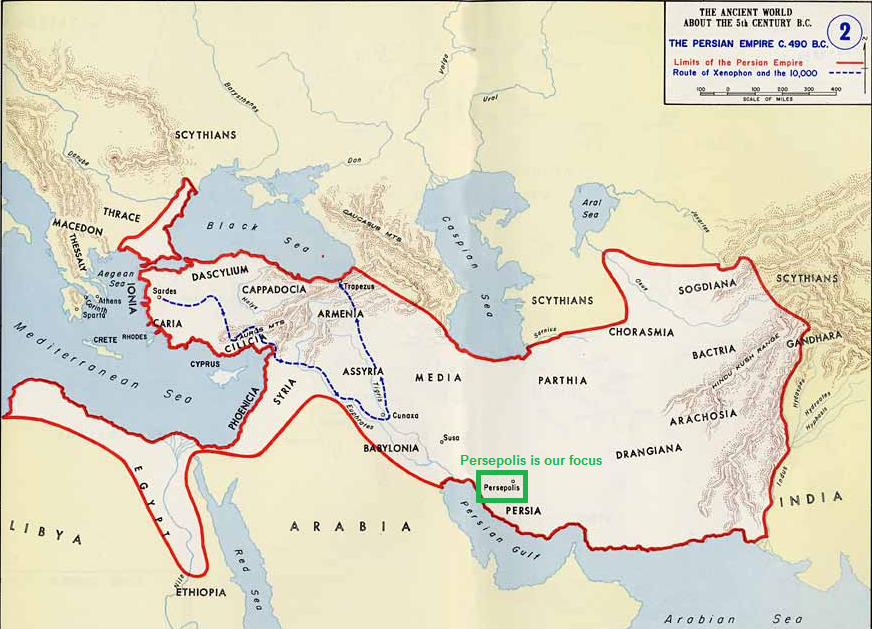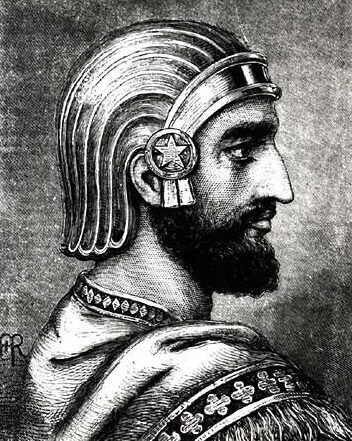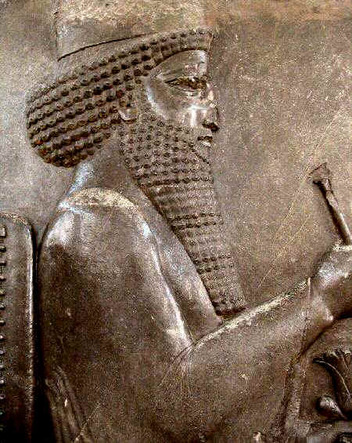Public Administration Case Study
Abigail Hager
The Persian capital at Persepolis was a marvel of positive public administration.
During the Second Wave civilizations, Persia was the ruler of the Near East. They had the largest empire known to humankind of their time, the Persians were led by some of the most effective and revered leaders; had a essentially common form of government, but implemented it more effective than other empires; they had laws covering nearly anything that could transpire; and the means to create a vast, impacting empire.
LeadersThe Persian capital Persepolis was a marvel of positive public administration, most especially under Cyrus the I, 559 -530 BCE (30 years), and Darius I, 522 BC-486 BCE (36 years).
Cyrus I, or Cyrus the Great, was the founder of the Achaemenid Empire in 559 BCE, and ruled for 30 years. He was best known for his religious and cultural tolerance, which was continued in later reigns. He allowed all conquered people to practice their religion and their culture, without Persian interference. Another distinguishing factor of how Cyrus lead was that he took no slaves. War did not end in taking prisoner slaves, they were incorporated as paid workers. Those paid workers were employed by the government to build all of Persia's many monuments and public works. Darius I ruled after Cyrus for 36 years. Darius also practiced religious and cultural tolerance, and expended on what Cyrus started. Cyrus compiled the Persian empire, but died before he could unite it. Darius was able to unite it using the same policies and administration techniques as Cyrus. He continued the practice of paid workers building public works, and built more monuments. |
GovernmentThe setup of the Persian government was in ways similar to other Second Wave Civilizations, it was a large central empire ran primarily by one person. It had differences as well, and those are the focus when referring to government structure.
The empire was divided into 20 provinces, or Satrapies. Every Satrapy had their own capital, but the main capital for the entire empire was Persepolis. Each of the Satrapies was ruled by a governor called a Satrap. They had rule as the Satrap, but were still expected to be loyal to the King's wishes. To ensure of this, the King appointed a Secretary and Military official to watch the Satrap and report any disloyalty. If disloyalty was reported the Satrap and any other guilty party was brought to Persepolis for trial. Even more effective than the Secretary and Military watchmen were the king’s own person spies. They were special inspectors, referred to as the"the Eyes and Ears of the King.” They traveled throughout the Empire watching the Satraps and the people for any signs of disloyalty or uprising. If any disloyalty or treason was found, the individual was brought to the capital at Persepolis and tried, the punishment ranging in severity depending on the scope of the accusation, or the sex of the offender. |
BureaucracyThe empire had a centralized bureaucratic administration, inspiring similar developments in later empires.
While the King had supreme rule, underneath him were the 20 Satraps previously mentioned. Since those Satraps were charged with a portion of the empire, they collected taxes for their area. The Satraps themselves didn't do it, so they hired a bureau in charge of collecting the appropriate tax amount; the same is true for the capital of Persepolis. They served as one bureaucratic institution in the government, but there were many more. Record keepers and scribes were employed by the government, to work for both the King and the Satraps. There were hundreds of scribes working for Cyrus in Persepolis, and they commonly portrayed him as a father figure, a liberator, and even in Jewish society a Messiah. To work alongside the scribes were royal translators. While the official language in Persian was Aramaic, Persepolis was a massive center of trade, so foreign people were always there and in need of translators. |
LawsFollowing Hammerabi's Code in Babylon, Persia created a collection of Laws in the Book of Law.
The Books of Law dealt with Court and Magisterial Law, Law for Injuries to Person and Property; Laws pertaining to Theft, Misappropriation and Cruelty to Animals and many more. These set down precedence for sentencing and punishment. It outlined what the various law was, what act was in defiance of it, and how to sentence that violation. Evident of that time period however, each sentencing was different based on the offender's sex, age, and social class. Lower class got harsher sentences than higher class, and women always got the worst sentences of the lot. |
Public Works
Persepolis was the culmination of every public work project the Persians completed.
Cyrus created the garden Paradaisia, which became an example for rich palace gardens for centuries after. Within that garden and in the city proper limestone canals in the ground brought mountain water to small ponds, or in the city to small cisterns. The people could then gather their water from said cistern.
Darius did even more for Persepolis. He created a common coinage, making it much easier for Persia to trade, making more money. Darius also made Aramaic the official language in Persia, making every aspect of administration simpler. He commissioned a waste drainage system for the houses in the city walls. It used limestone canals and lead pipes to drain waste out underground and out the city walls. That meant indoor plumbing for those living in Persepolis, which was much healthier than other civilizations. Darius also commission the Royal Highway and the Darius Canal. The Royal Highway spanned the west half of the Empire, and connected the empire with more than 1,000 rest stops and inns. The Postal System Darius created used this highway to transport mail and goods expediently. To connect the Persian empire East and West, Darius created the Darius Canal. It took 7 years to build, and linked the Persian Empire to the Mediterranean, the Red Sea, and the Nile River. Both the road and the canal allowed for ease of communication. That ease of communication allowed the King to better execute the laws desired, thus boosting the effectiveness of the Public Administration.
Cyrus created the garden Paradaisia, which became an example for rich palace gardens for centuries after. Within that garden and in the city proper limestone canals in the ground brought mountain water to small ponds, or in the city to small cisterns. The people could then gather their water from said cistern.
Darius did even more for Persepolis. He created a common coinage, making it much easier for Persia to trade, making more money. Darius also made Aramaic the official language in Persia, making every aspect of administration simpler. He commissioned a waste drainage system for the houses in the city walls. It used limestone canals and lead pipes to drain waste out underground and out the city walls. That meant indoor plumbing for those living in Persepolis, which was much healthier than other civilizations. Darius also commission the Royal Highway and the Darius Canal. The Royal Highway spanned the west half of the Empire, and connected the empire with more than 1,000 rest stops and inns. The Postal System Darius created used this highway to transport mail and goods expediently. To connect the Persian empire East and West, Darius created the Darius Canal. It took 7 years to build, and linked the Persian Empire to the Mediterranean, the Red Sea, and the Nile River. Both the road and the canal allowed for ease of communication. That ease of communication allowed the King to better execute the laws desired, thus boosting the effectiveness of the Public Administration.
Engineering and Empire - The Persians (part 2 of 5)
The Persian Empire II. Digital image. Greek and Roman Historians Classics 370. George Mason University, n.d. Web. 28 Oct. 2012. <http://www.thelatinlibrary.com/historians/maps/persianempire.jpg>.
http://history-world.org/persians.htm
Engineering an Empire - The Persians (part 2 of 5) http://www.youtube.com/watch?v=nSm68TxRBRo&feature=channel&list=UL
http://history-world.org/persians.htm
Engineering an Empire - The Persians (part 2 of 5) http://www.youtube.com/watch?v=nSm68TxRBRo&feature=channel&list=UL



